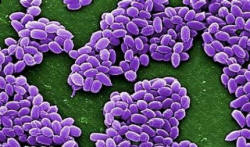|
 CDC
appoints new safety czar to improve handling of dangerous pathogens CDC
appoints new safety czar to improve handling of dangerous pathogens
 Send a link to a friend
Send a link to a friend
[September 16, 2015]
By Julie Steenhuysen
CHICAGO (Reuters) - The U.S. Centers for
Disease Control and Prevention on Tuesday tapped Dr. Stephen Monroe, a
longtime lab scientist and agency insider, to oversee the safe handling
of dangerous pathogens by more than 2,000 scientists in the agency's
more than 150 labs.
|
|
Monroe becomes the CDC's first permanent associate director of lab
safety, reporting directly to the director.
Creating a new high-level safety position was a key recommendation
of a months-long internal investigation into the mishandling of
anthrax, bird flu and Ebola in CDC labs in 2014, according to an
internal CDC memo obtained by Reuters in December.
Monroe's appointment comes more than a year after CDC chief Dr.
Thomas Frieden faced an angry panel of lawmakers in the summer of
2014 who faulted a "dangerous pattern" of safety lapses in CDC labs,
and called for an overhaul at the agency.
CDC spokesman Tom Skinner explained the lag in hiring the lab safety
director by saying: "The job requires a very specific and special
skill set. Finding the right person has simply taken time because of
that."
Since 2014, several other government labs have reported mishandling
of pathogens, including the U.S. FDA's disclosure in July 2014 that
if found vials of smallpox from the 1950s, and most recently, the
disclosure that the U.S. Defense Department botched the handling of
live anthrax and Yersinia pestis, the bacteria that causes the
plague.
Monroe has spent 28 years in various scientific posts at CDC,
including 11 years as lab scientist working with pathogens such as
anthrax, Ebola and Marburg.
In an interview with Reuters, he said his credibility as a bench
scientist - his "bench cred" - should go a long way toward bringing
about the necessary culture change to help elevate lab safety at the
agency.
One of his first priorities is to focus on patterns of errors that
will allow CDC to quickly identify weaknesses in process that can
lead to safety lapses.
That might have helped CDC avoid repeated problems with steps needed
to inactivate deadly pathogens, such as anthrax or bird flu, before
they were shipped to laboratories with lower levels of biosecurity
protections.
[to top of second column] |

"What became clear last year with the incidents was that we, as an
agency, were responding to incidents one at a time and not
recognizing patterns," Monroe said.
He also plans to establish best practices for lab science and safety
that will be adopted agency-wide.
Several experts had criticized CDC because its labs operated in
silos, allowing its world-class scientists to set their own policies
on how keep their labs safe.
"What we're trying to do is have a more consistent approach to
things so we can use the same yardstick," he said.
Although his office is not handing oversight of the recent safety
lapses in Defense Department laboratories, Monroe said part of his
role is to represent the CDC in discussions with other federal
agencies on matters of lab safety.
(Reporting by Julie Steenhuysen; Editing by Cynthia Osterman)
[© 2015 Thomson Reuters. All rights
reserved.] Copyright 2015 Reuters. All rights reserved. This material may not be published,
broadcast, rewritten or redistributed. |